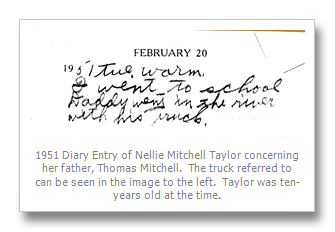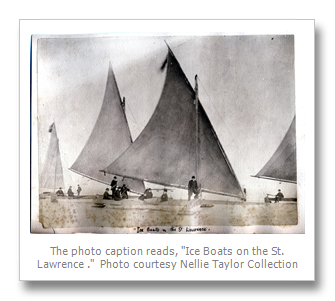My grandfather, Thomas Mitchell (1913-1990), told me many stories about life on the river during the winter months. Many winter jobs were actually tied to the area’s economic engine of tourism. They had to fill the icehouse (already posted on the Riverstories.org website). They moved houses between islands by sliding them across the ice. Dock work was often performed on the ice where it served as an excellent working platform.

But there were also stories of survival — ice fishing to put food on the table or trips to Clayton by sleigh or truck for supplies ranging from food to coal to Christmas presents. And sometimes tragedy struck, as when four members of the Charles Hagerman family (the mother, two sons, and a daughter) fell through the ice in front of their homestead at Waterson’s Point on Wellesley Island around Christmas day, 1898. (Hear the Story of the The Tragedy at Waterson’s Point and read excerpts from newspapers and other sources at http://riverstories.org/Riverstories/Tragedy_at_Watersons_Point.html).
One of my favorite stories, alas not captured on tape, is of Chancy Patterson driving into South Bay from somewhere with his truck, witnessed by my grandfather who was on shore near the South Bay Ice House. The truck began to fall through the ice, so Chancy gunned it. Ice flew up from behind the truck and Chancy carved a channel all the way to the icehouse ramp.
For at least the second year in a row, we’re in the midst of what I would call an open winter — a year when the main channels remain as open water with no ice. I believe this is unprecedented. Yes, there have been open winters in the past, but they were infrequent, maybe once a decade, and not two years in a row, to my knowledge. This concerns me on multiple levels, and I believe it should concern everyone with a love of the river, indeed, of the planet.
I believe we are entering a new era of river winter meteorology that could have innumerable impacts from the amount and duration of lake effect snows on Central New York, to the ability to form an ice bridge to Grindstone Island and other locales. Then there are the ecological effects on the river bottom which, for eons, has experienced an extended period of calm caused by the sheet of ice above.
Finally, and perhaps most devastating, there will be a renewed call for winter navigation as there will be virtually no ice in the shipping channel. Unfortunately, the displacement effects of large ships will only be exacerbated by the ice still locked in the bays and along the shore, just as it is this year. Imagine that ice being lifted and lowered by several inches every time a ship goes by — the effect to fragile wetlands and docks would be disastrous.
In the hopes of raising awareness to the impacts of climate change along the river, I have posted four new stories from the RiverStories archives.
First, my Great Uncle, Grant Mitchell (1900-1979), Executive Secretary of the the Thousand Islands Bridge Authority from 1938 to 1972, speaks about how the winters seemed “longer and colder” when he was a kid. Interestingly, this observation was made in the mid-1970s, before Global Warming was even on the radar for scientist. He also explains how people “depended on ice for transportation.” From the recording, it sounds as if people would skate to Clayton while pushing an ice punt, although we know that people also traveled by iceboats, sleigh, vehicle, foot, and horseback. His recollections can be found in Crossing to Clayton for Supplies.

Another task that often occurred during the winter months on the ice was the moving of houses. My grandfather moved a lot of houses over his lifetime as a contractor at Thousand Island Park — many times just a few blocks. But one time he towed an old kitchen shed from T.I. Park through the Narrows and over the current Wellesley Island State Park isthmus with a multi-ton World War I Continuous Track Gun Carrier. The structure would eventually become his camp on Crow Island, across from Ivy Lea. He tells about the ice shaking experience in Hauling the Camp to Crow.
Finally, it was common to use the ice as a bridge to ferry materials from one location to another. In Truck Thru the Ice, my grandfather tells about one time when his truck fell through the ice with a load of stone from Picton Island. Somehow they had the truck out and running again by the next morning, but it was late into the night before they got home. My mother recalls how they were pacing the floor, “getting ready for death,” sure that the men had fallen through the ice. She was ten at the time, but she was keeping a journal even then. Her entry for the day reads, February 20, 1951 Tue. Warm. I went to school. Daddy went in the river with his truck.
There are surely more stories of life on the river during the winter. Some are in the archives, and I will attempt to post them as I can. Hopefully, there are more to be discovered. Regardless, may they inspire you to appreciate the river in new light.
By Tom French
Tom French was raised on Wellesley Island at Thousand Island Park. His book, River Views: A History of the 1000 Islands in 3-D, was recently awarded a Silver Medal for Best Regional Non-Fiction Book in the Northeast in the 2012 Independent Publishers Book Awards. (see our Publications page for details). His work has been featured in Mac|Life Magazine, Adirondack Life, Stereo World,TI Life and The Watertown Daily Times. Several of his commentaries have aired on North Country Public Radio . In addition, he is a member of the band, The Buoyrockers.
TI Life published one of Tom’s short stories in our July 2012 issue, “Mom Makes River a Garden,” A Short Story from his new eBook now available on Smashwords and Amazon. Wind Water Waves is a collection of nine short stories reflecting on various characters' relationships with "The River."
In April 2012, Tom introduced his “River Stories” to TI Life. His website is popular as it captures life of old with real voice and wonderful images. Enjoy!